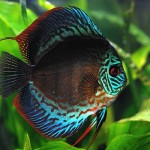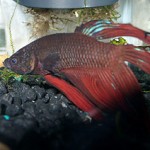Scientific Name:
Lysmata wurdemanni.
Identification:
Peppermint Shrimp are opaque to creamy-clear in color, with red or maroon colored stripes running along the length of the body. Often misidentified or misrepresented and sold as the Camelback Shrimp (Rhynchocienetes uritai), these two species are NOT the same and should not be confused. This is the only TRUE Peppermint Shrimp.
Characteristics:
Peppermint Shrimp are nocturnal and very shy during the day, protecting themselves from predators by staying out of sight most of the time. However, at night when the big boys are napping, this shrimp forages the system looking for a meal.The Lysmata wurdemanni is generally peaceful with other tank inhabitants, but may not get along well with Coral Banded Shrimp of the same sex, and may pick on other shrimp species as well. <P> To help with proper molting of this shrimp, supplemental iodine should be added to the system. Like with all invertebrates, this shrimp is sensitive to copper sulfate and high nitrate levels.

Diet:
The Peppermint Shrimp is a carnivore, scavenging the bottom of the aquarium, and sifting sand for food. In captivity it will accept a varied diet of prepared fresh and frozen foods suitable for carnivores, vitamin enriched flakes, freeze dried krill, or live adult brine shrimp or nauplii. Best fed at least once per day.
Reef Tank Suitability:
This shrimp is known for eating aiptasia anemones! It eat them like candy! Place 3 or 4 to a tank to really clean up infestations. Once all the anemones are gone though, you must provide food for them. Don’t allow the aiptastia to grow larger than an inch or so, because the shrimp won’t go after really large ones. Add the shrimp early on in the beginnings of the reef, after cycling of course! This will help to keep the anemones from over running the tank in the first place!

















Leave a Reply